#beinhaus
Text

Inspired by the ossuary in Hallstatt - Austria (Under the cut)
I made this in February to get out of artblock and have some fun after reading through the books of Dr. Paul Koudanaris (@hexenkult on Instagram if anyone wants to check him out). Not super proud of it, but I did have fun, so I consider it a successful drawing.

Ossuary in Hallstatt, Austria - Photo by Dr. Paul Koudanaris
#I have yet to figure out how to post traditional art#trans artist#dark art#death positive#ossuary#memento mori#traditional art#watercolour art#Beinhaus#skulls#artists on tumblr#queer artists#dark aesthetic#Catholic art#i am not Catholic but ossuaries sure are and i like the look#something something my deadname is in there with the names of many of my ancestors#and even though so many of us share names so many stay unknown#and if my name were to be remembered on my own skull right now it wouldn't be my own#are the people whose names were forgotten the unlucky or the lucky ones#there's a lot of personal symbolism in this that i can't go into in detail#my art
48 notes
·
View notes
Text

#original photography#original photographer#monochrome#photographers on tumblr#beinhaus#dark#ossuary
2 notes
·
View notes
Text

Rudolf Sieber-Lonati - Das Beinhaus der Medusa
31 notes
·
View notes
Text
El Osario de Sedlec (también conocido como Kostnice Ossuary Beinhaus)...

LOS 40.000 A 70.000 ESQUELETOS dentro del Osario de Sedlec (también conocido como Kostnice Ossuary Beinhaus) en la República Checa le dan la bienvenida, literalmente, con los brazos abiertos.
Conocida por la mayoría como "la Iglesia de los Huesos", muestra algunas de las obras de arte más macabras del mundo. Además de un espléndido candelabro de hueso compuesto por casi todos los huesos del cuerpo humano, el osario exhibe dos grandes cálices de hueso, cuatro candelabros barrocos de hueso, seis enormes pirámides de hueso, dos custodias de hueso (un recipiente utilizado para exhibir la hostia eucarística), un escudo familiar en (lo adivinaste) hueso y candelabros de calavera. Cadenas de hueso que se enrollan festivamente se cuelgan como papel crepé en una fiesta de cumpleaños.
En 1870, se contrató a un tallador de madera local, František Rint, para la oscura tarea de arreglar artísticamente los miles de huesos. A Rint se le ocurrió el impresionante candelabro de Bone Church, así como el asombroso escudo de armas de Schwarzenberg, que incluye un cuervo picoteando la cabeza cortada de un turco, todo hecho de hueso humano. Rint se encargó de blanquear todos los huesos del osario para darle un aspecto uniforme a la habitación. La firma de su artista todavía está en la pared hoy en día, naturalmente, en su medio de elección, el hueso.
#Osario de Sedlec (también conocido como Kostnice Ossuary Beinhaus) en la República Checa le dan la bienvenida literalmente con los brazos ab#¿Esta es la imagen y algunos datos (O no) la “Historia” la pones tú? ¡La tuya! ¿Lo harás...?
1 note
·
View note
Text
I’m still working on invoicing and I likely will have to finish tomorrow, just a heads up 😊 please don’t worry if I haven’t responded to you yet.
While I take a little break, I just wanted to list some of the videos I have been meaning to edit but keep forgetting to.
List of all my favorite things I’ve foraged since moving back to Austria
The medieval ruins I visited last month
Some history of Hallstatt + the Beinhaus there
Identifying wild garlic for foraging
Chia pudding w seasonal rhubarb recipe/idea
An electroformed jewelry piece from beginning to end showing all of the steps
I think that was it for now. I’m also still working on my patreon and I’ll announce the launch date soon 💞
It’s nice to not restrict myself to one “niche” and just do videos about whatever I feel like 😅 even though it’s probably limiting my reach on other platforms - at least tumblr is still chronological for now haha
31 notes
·
View notes
Text
Den letzten Text, den wir im Goethe/Schiller Seminar besprechen, ist übrigens "Im ernsten Beinhaus wars" bzw. "Bei Betrachtung von Schillers Schädel", und ich sollte Schmerzensgeld von meinem Dozenten verlangen. Aua.
#das ganze semester über reden wir darüber was für eine wunderbar produktive freundschaft die hatten#UND DANN ENDET DAS MIT GOETHES GEDICHT ÜBER SCHILLERS KOPF#mir geht es gut warum fragt ihr#ich bin normal über die tatsache dass goethe ''schillers'' schädel geklaut und auf seinem schreibtisch#auf einem blaues samtkissen unter einer glasglocke liegen hatte#(das ist und bleibt eins der top 10 romantischsten dinge jemals)#(ist es gruselig? ja okay auch. ABER ER HAT IHN SO GESCHÄTZT DASS ER EINFACH LITERARISCH SEINEN SCHÄDEL IN SEINEM ARBEITSZIMMER WOLLTE....)#diese zwei machen mich so fertig ey#goethe#schiller#schoethe#german stuff#own
40 notes
·
View notes
Text




The Sedlec Ossuary (Czech: Kostnice v Sedlci; German: Sedletz-Beinhaus) is a Roman Catholic chapel, located beneath the Cemetery Church of All Saints (Czech: Hřbitovní kostel Všech Svatých), part of the former Sedlec Abbey in Sedlec, a suburb of Kutná Hora in the Czech Republic. The ossuary is estimated to contain the skeletons of between 40,000 and 70,000 people, whose bones have, in many cases, been artistically arranged to form decorations and furnishings for the chapel.
Four bell-shaped mounds occupy the corners of the chapel. A chandelier of bones, which contains at least one of every bone in the human body, hangs from the center of the nave with garlands of skulls draping the vault. Other works include piers and monstrances flanking the altar, a coat of arms of the House of Schwarzenberg, and the signature of František Rint, also executed in bone, on the wall near the entrance.
5 notes
·
View notes
Text

¡Hola, buenos días, humanidad! 🌍 ¡Feliz viernes! 💪🌟🚀🏆🌈📈🌱🌞🎯🌺 Hoy os dejo la postal de Hallstatt, una joya pintoresca en Austria, conocida como una de las localidades más hermosas del mundo. Anidada entre los Alpes y bordeando el idílico lago Hallstätter See, esta pequeña ciudad es famosa por sus casas de colores pastel que se reflejan en las aguas serenas. De manera notable, Hallstatt es reconocida por su historia prehistórica y la cultura celta, siendo el sitio de uno de los primeros asentamientos humanos en Europa. La llamativa mina de sal de Hallstatt, que data de la Edad del Bronce, ha contribuido a la riqueza histórica del lugar. Además, la peculiaridad del Cementerio Beinhaus, donde los huesos se muestran artísticamente decorados, añade un toque distintivo a esta pintoresca ciudad alpina, declarada Patrimonio de la Humanidad por la UNESCO.
Para tener en cuenta...
A veces, cuando piensas mucho en las cosas, todo parece enredarse en tu cabeza. Repites pensamientos una y otra vez, imaginando situaciones que tal vez ni existan o que nunca sucederán. Es importante dejar de analizar demasiado las cosas y no convencerte de que estás solo en esto. El exceso de pensamiento crea un círculo difícil de romper, así que habla con alguien más al respecto. Si te das cuenta de que te estás preocupando mucho, habla con un amigo y comparte lo que piensas. Descubrirás que al hablar de tus preocupaciones con alguien, te sentirás más fuerte y sabrás que no estás solo.
2 notes
·
View notes
Text
These 5 Creepy Churches Are Decorated With Human Bones
Halloween is here, which means now is the time to explore the creepiest places in the world. What we weren't quite prepared for, though, was just how many terrifying churches made from human remains there were out there. These five sacred buildings are straight out of a doom-metal video.
5. Sedlec Ossuary in Kutná Hora, Czech Republic
There are churches with a major skeletal theme, and then there are bone churches. Sedlec Ossuary is definitely the latter. It's got two massive chalices of bone, obviously. It's got four baroque candelabras of bone, because of course it does. But then it's got some distinctly church-y skeletal elements as well. Embedded in the walls, you'll find two monstrances. Those are vessels to display the Eucharistic host — picture a skull with a display of femurs radiating out from the center. It's a striking image, but you might not even notice them. Hanging above the morbid nave is an enormous chandelier composed of nearly every bone in the human body.
4. Capuchin Crypts in Rome, Italy
We took you inside the crypts at Santa Maria della Concezione once before. But if there's any place that's worth revisiting in the spookiest season of all, it's the crypt that features a skeleton in the image of the Grim Reaper, complete with a scale and scythe — also made of bones, of course. Despite the macabre decor, this crypt was adorned with the remains of Capuchin friars who died between 1528 and 1870 when the order relocated to Rome so that all of the monks, living and dead, could be kept in the same place.
3. Hallstatt Karner in Hallstatt, Austria
Many bone churches and ossuaries are decorated with femurs and pelvises, but at Hallstatt Karner, the skulls themselves are decorated. More than 600 of the skulls on display in this beinhaus (bone house, in English) bear their former owners' names, professions, and the date of their death. Many are also adorned with decorative garlands and flowers. But perhaps what makes this bone church stand out the most is the fact that the most recent remains to be interred here belong to a woman who passed away in 1983, after having requested the beinhaus as her final resting place. What's more, she might not be the last — the church is still open to receiving similar requests.
2. Wamba Ossuary in Wamba, Spain
Unlike Sedlec and the Capuchin crypts, Wamba Ossuary isn't so much decorated with bones as much as packed to the gills with them. These remains weren't placed here for religious or sentimental reasons. They were stacked here out of necessity, as the local cemetery became overcrowded between the 12th and 18th centuries. There are thousands of bodies here. And the wall you see upon entering the space might take you a moment to resolve into what it really is: a densely packed wall of bones, studded with more than 3,000 human skulls.
1. Skull Chapel in Czermna, Poland
The bones and skulls of more than 21,000 people fill Skull Chapel. This isn't like Sedlec, where all of the furnishings of the church are made of bone. Here, the walls themselves are lined with bones and skulls instead of drywall. It was created by a local priest, Vaclav Tomasek, who between the years of 1776 and 1804 gathered and cleaned the remains from the shallow graves left behind after the Thirty Years' War, Silesian Wars, and cholera outbreaks. He placed what he deemed significant bones on the altar, including the skull of the local mayor, skulls with bullet holes, a skull deformed by syphilis, and the bones of a supposed giant. When Tomasek died, his skull was placed on the altar as well.
This article first appeared on Curiosity.com. Click here to read the original article.
1 note
·
View note
Text
The most photographed location in Europe.
Hallstatt, Austria: A Complete Introduction
Hallstatt is a picturesque village nestled in the Salzkammergut region of Austria, renowned for its stunning natural beauty, rich history, and charming lakeside setting. Here’s a detailed introduction to Hallstatt:

Location and Geography
Location: Hallstatt is located in the Salzkammergut region of Austria, situated on the western shore of Hallstätter See (Lake Hallstatt). It is surrounded by the Dachstein Alps, offering breathtaking views of mountains, forests, and the crystal-clear waters of the lake.
Scenic Setting: The village is known for its postcard-perfect setting, with colorful historic buildings clustered along the lakefront and mountains rising steeply behind them. Hallstatt's beauty has earned it recognition as a UNESCO World Heritage site.
History and Cultural Heritage
Salt Mining: Hallstatt is famous for its long history of salt mining, which dates back over 7,000 years. Salt ("white gold") played a crucial role in the region's economy and cultural development, influencing architecture, trade, and traditions.
Archaeological Finds: The Hallstatt period (800-400 BC) is named after the village due to the extensive archaeological discoveries made in the area. These artifacts are crucial for understanding the early Iron Age in Europe and are housed in the Hallstatt Museum.
Attractions and Landmarks
Hallstatt Marktplatz: The central square of Hallstatt, lined with charming historic buildings, cafes, and shops. It is a bustling hub where visitors can experience the local culture and architecture.
Salt Mine (Salzwelten Hallstatt): Visitors can explore the historic salt mine, which offers guided tours showcasing the mining techniques used throughout history. The mine features underground tunnels, slides, and a subterranean salt lake.
Dachstein Ice Cave: Located nearby, the Dachstein Ice Cave is a natural wonder with stunning ice formations and underground chambers accessible via guided tours.

Outdoor Activities
Boat Tours: Scenic boat tours on Lake Hallstatt offer panoramic views of the village and surrounding mountains. This is a relaxing way to enjoy the natural beauty of the area.
Hiking and Nature Trails: Hallstatt is a paradise for hikers and nature enthusiasts, with numerous trails leading through alpine meadows, forests, and along the lakeshore. The nearby Dachstein-Krippenstein area offers challenging hikes and stunning vistas.
Cultural Experiences
Hallstatt Charnel House (Beinhaus): A small chapel near the village cemetery houses a collection of painted skulls and skeletal remains, reflecting local burial customs and traditions.
Local Cuisine: Hallstatt offers a variety of traditional Austrian dishes, including Wiener Schnitzel, strudel, and local fish specialties. Visitors can enjoy these delicacies in cozy restaurants overlooking the lake.

Practical Information
Accessibility: Hallstatt is accessible by car, bus, or train from Salzburg or Vienna. The village is pedestrian-friendly, with parking available outside the center due to limited vehicle access.
Accommodation: Hallstatt offers a range of accommodations, including hotels, guesthouses, and vacation rentals. Staying overnight allows visitors to experience the village's tranquil atmosphere after day-trippers have left.
Best Time to Visit: Hallstatt is beautiful year-round, with each season offering its own charm. Summer (June to August) is popular for outdoor activities, while spring and fall offer fewer crowds and colorful landscapes.
Conclusion
Hallstatt, with its idyllic lakeside setting, rich history, and stunning natural surroundings, captivates visitors with its timeless beauty and cultural heritage. Whether you're exploring ancient salt mines, hiking through alpine meadows, or simply savoring local cuisine by the lake, Hallstatt promises an unforgettable experience in the heart of Austria's Salzkammergut region.
Worth to go : 7/10
Thanks for reading ♥
0 notes
Text
The Best Small Towns in Europe for a Charming Getaway
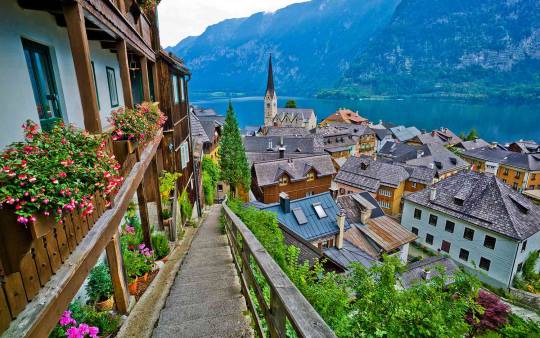
Europe, with its rich history and diverse cultures, is not just about its bustling cities. Tucked away from the urban sprawl, small towns across the continent offer travelers a charming and intimate escape. Let’s embark on a journey through some of Europe's most enchanting small towns.
The Allure of European Small Towns
European small towns are a tapestry of history, culture, and stunning natural landscapes. They offer a slower pace of life, allowing travelers to immerse themselves in local traditions, savor regional cuisines, and explore historical landmarks without the crowds of larger cities.
1. Hallstatt, Austria
Nestled between the dramatic Dachstein Alps and the tranquil Hallstätter See, Hallstatt is often described as one of the most beautiful lake towns in the world. This UNESCO World Heritage site in Austria is a perfect blend of natural beauty and rich history.
Scenic Splendor: Hallstatt's unique location offers stunning views of steep mountains plunging straight into the mirror-like lake. The town is a paradise for photographers and nature lovers.
Historical Significance: Known for its salt production, Hallstatt has a history dating back to prehistoric times. The Hallstatt Salt Mine, accessible by a funicular, offers a journey into the town’s ancient mining history.
Charming Architecture: Wander through Hallstatt’s market square, and you’ll be surrounded by charming 16th-century alpine buildings, adding to the town’s storybook feel.
Cultural Attractions: Visit the Beinhaus (Bone House) at St. Michael's Chapel, a unique repository for painted skulls, or explore the archaeological treasures at the Heritage Museum.
2. Colmar, France
Colmar, in the Alsace region of northeastern France, is often likened to a medieval fairytale town. With its well-preserved old town, Colmar is a fusion of German and French cultures, rich in architectural landmarks, gastronomy, and vibrant street life.
Architectural Wonderland: Colmar’s streets are lined with half-timbered medieval and early Renaissance buildings, with the Maison Pfister and the Koïfhus being notable examples.
Little Venice: The district of Little Venice, with its picturesque canals and colorful houses, is a must-visit. Boat tours offer a unique perspective of the town.
Wine and Cuisine: As part of the Alsace wine region, Colmar is an ideal base for wine tasting tours. The local Alsatian cuisine is a delightful blend of French and German influences.
Cultural Festivals: The town hosts several festivals throughout the year, including the Colmar International Festival, celebrating classical and jazz music.
3. Giethoorn, Netherlands
Known as the "Venice of the North," Giethoorn is a peaceful village in the Netherlands where traditional thatched houses and wooden bridges dot a network of canals. The absence of cars in the town center makes for a quiet, idyllic setting.
Waterways and Boating: The main mode of transport in Giethoorn is by boat. Travelers can rent a "whisper boat," which, as the name suggests, moves quietly through the water, ensuring the serenity of the village is maintained.
Picturesque Scenery: The village offers scenic views of lush greenery, charming houses, and beautifully maintained gardens. It’s a haven for those seeking tranquility and natural beauty.
Walking and Cycling Paths: For those who prefer land, Giethoorn has lovely walking and cycling paths along the canals, offering a different but equally charming perspective of the village.
Nearby Attractions: The nearby De Weerribben-Wieden National Park is perfect for nature lovers and bird watchers, providing a beautiful backdrop of reed beds, marshes, and woodland.
4. Ronda, Spain
Perched atop a towering cliff in the province of Málaga, Ronda is one of Spain's oldest towns, offering a dramatic setting and rich history.
Breathtaking Views: Ronda is famous for its Puente Nuevo, a stone bridge spanning a deep gorge, offering stunning views of the Andalusian landscape.
Historical Richness: The town's history, influenced by Roman and Moorish cultures, is evident in its architecture, including the Moorish baths and the Mondragón Palace.
Cultural Experience: Ronda has a strong bullfighting tradition, showcased at the Plaza de Toros, one of the oldest and most revered bullrings in Spain.
Natural Surroundings: The surrounding countryside is perfect for hiking and exploring nearby vineyards, where visitors can indulge in local wine tasting.
5. Český Krumlov, Czech Republic
Český Krumlov, in the South Bohemia region, is a jewel of medieval architecture and cultural heritage.
Fairy-tale Ambiance: The town’s centerpiece is the Český Krumlov Castle, with its baroque gardens and an original 17th-century baroque theater.
Renaissance and Gothic Architecture: Wander through cobbled streets lined with Gothic, Renaissance, and baroque buildings, preserved beautifully over centuries.
Cultural Festivities: The town is lively with cultural events, including the famous Český Krumlov International Music Festival and traditional craft markets.
River Adventures: The Vltava River meanders through the town, offering canoeing and rafting opportunities for adventure enthusiasts.
6. Portree, Scotland
Portree, the largest town on Scotland’s Isle of Skye, is known for its picturesque harbor and stunning natural scenery.
Colorful Waterfront: The harbor, lined with brightly colored houses, is the heart of the town, rich in maritime history.
Gateway to Natural Wonders: Portree is the perfect base for exploring Skye’s rugged landscapes, including the Old Man of Storr, the Quiraing, and the Cuillin mountains.
Scottish Culture: Visitors can immerse themselves in Scottish culture, with traditional music often heard in the town’s pubs and restaurants.
Wildlife Watching: Boat trips from Portree harbor offer opportunities to see a variety of marine wildlife, including seals, dolphins, and sometimes even whales.
7. Bled, Slovenia
Bled, with its emerald-green lake, church-topped islet, and medieval castle set against the Julian Alps, is a slice of paradise in Slovenia.
Iconic Lake Bled: The glacial Lake Bled is famous for its small island home to the 17th-century Church of the Assumption, accessible by traditional ‘pletna’ boats.
Bled Castle: Perched atop a cliff overlooking the lake, Bled Castle offers panoramic views and a glimpse into Slovenia's history.
Active Leisure: The area is ideal for hiking, cycling, and in winter, skiing in the nearby mountains.
Culinary Delight: Don't miss tasting the famous Bled cream cake, a delightful local pastry.
8. Bibury, England
Nestled in the rolling Cotswold Hills, Bibury is often described as the most beautiful village in England. It’s a quintessential English hamlet renowned for its traditional stone cottages and pastoral landscapes.
Arlington Row: A famous row of picturesque cottages dating back to the 17th century, originally built as a wool store and converted into weavers' cottages.
Trout Farm: The Bibury Trout Farm is one of Britain's oldest, offering a delightful family experience and an opportunity to catch your own dinner.
Walking Paradise: The village is surrounded by lush meadows and walking paths, perfect for leisurely strolls and picnics by the River Coln.
Architectural Charm: Bibury encapsulates old-world charm with its stone bridges, traditional English gardens, and the historic St. Mary's Church.
9. Manarola, Italy
Manarola, one of the Cinque Terre villages on the Italian Riviera, is a vibrant and picturesque seaside town known for its stunning views and vibrant architecture.
Colorful Houses: Manarola is famous for its brightly colored houses perched dramatically on rugged cliffs, overlooking the Mediterranean Sea.
Hiking Trails: The town is a hiker's paradise, with trails offering breathtaking coastal views, notably the Via dell'Amore that connects Manarola to Riomaggiore.
Wine and Gastronomy: Known for its Sciacchetrà wine, Manarola invites visitors to enjoy local Ligurian cuisine and seafood delicacies in its quaint eateries.
Water Activities: The rocky harbor is ideal for swimming and boating, providing a refreshing escape during the warm Mediterranean summers.
10. Rothenburg ob der Tauber, Germany
Rothenburg ob der Tauber is a well-preserved medieval town in Bavaria, Germany. It's like stepping into a time capsule with its enchanting old town surrounded by intact town walls.
Medieval Architecture: Wander through cobbled streets lined with half-timbered houses, medieval gates, and towers. The Plönlein intersection is a particularly picturesque spot.
Christmas Market: The town is renowned for its Christmas market (Reiterlesmarkt), one of the oldest in Germany, offering a magical festive experience.
Night Watchman’s Tour: A popular attraction, this tour provides an entertaining and informative stroll through the town’s history, guided by a night watchman.
The Crime Museum: For a unique experience, visit the Medieval Crime Museum, which showcases legal history with a collection of curious artifacts.
Conclusion
Each of these small towns offers a unique glimpse into Europe’s soul, away from the hustle and bustle of the big cities. They are perfect for travelers seeking a mix of relaxation, history, and natural beauty.
If you’re planning a European adventure and need help with your Schengen visa, GovAssist can provide expert assistance. They streamline the visa application process, making it easier for you to embark on your charming European getaway.
0 notes
Text
Welterbe (auf)gespürt und (er)fahren - AT - Kulturlandschaft Hallstatt-Dachstein im Salzkammergut

Das Welterbe Hallstatt-Dachstein / Salzkammergut steht seit 1997 als Kulturlandschaft, die durch die jahrtausendelange Tätigkeit von Bauern und Bergleuten eine entscheidende Rolle in der Geschichte der Menschheit gespielt und später durch ihre Harmonie und Schönheit viele Künstler inspiriert hat, auf der UNESCO-Welterbeliste. Bereits im 2. Jahrtausend v. Chr. begann hier in den Bergen die Salzgewinnung durch Verdampfen der Sole mithilfe des Holzes aus der Umgebung. Der Salzabbau verschaffte der Region Reichtum und weitreichende Handelsbeziehungen, die später durch die Habsburger Monarchie verwaltet wurden. Zentrum war die Stadt Hallstatt, deren Name Salzsiedlung bedeutet. Die Regionachstein ist geprägt von Bergen und alpinen Seen, von Alters her wird hier Wanderweidewirtschaft betrieben. Der Ort Hallstatt weist durch die Platznot an den steilen Hängen des Sees eine einzigartige Architektur auf. Nach einem Brand im Jahr 1750 wurden die Holzhäuser im spätbarocken Stil wieder aufgebaut. Die Schönheit der Alpenlandschaft mit ihren höher gelegenen Sommerweiden und den Talgemeinden wurde im frühen 19. Jahrhundert von Schriftstellern wie Adalbert Stifter und Franz Grillparzer in Romanen verarbeitet und auf vielen Gemälden der Biedermeier-Schule dargestellt. Ihnen folgte der Tourismus und es entstanden Hotels und Solebäder für Besucher. Das Dachsteinmassiv bildet eine der Pionierregionen des modernen Alpinismus. Hier ist das Einführungsvideo.
Es ist Wochenende, nachmittags und fantastisches Wetter. Ich bin also nicht die einzige, die Richtung Dachstein fährt. Die Seen im Tal leuchten türkis. In einigen Orten scheinen Feste stattzufinden und auch in Hallstatt gibt es keinen Parkplatz mehr. Ich bekomme das allerletzte schmale Fleckchen an der Straße vor dem Ort. So kann ich schon auf meinem Weg die Holzhäuser bewundern, die entlang des Sees am steilen Ufer stehen und komme am Fotopunkt des Ortes vorbei.


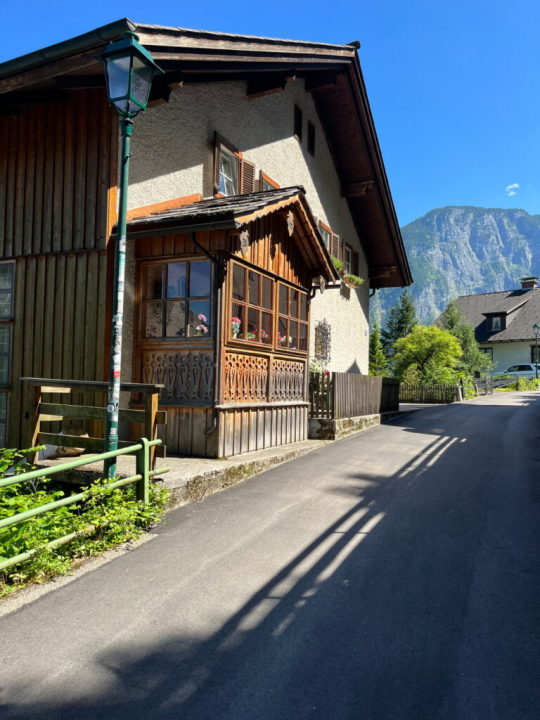


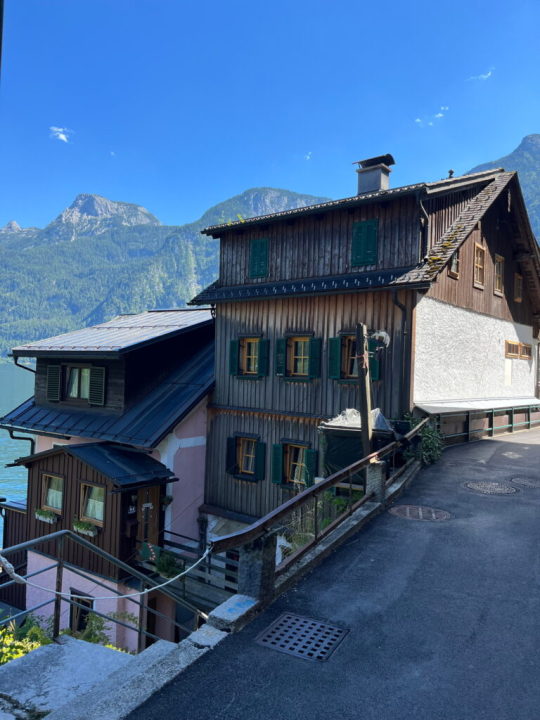



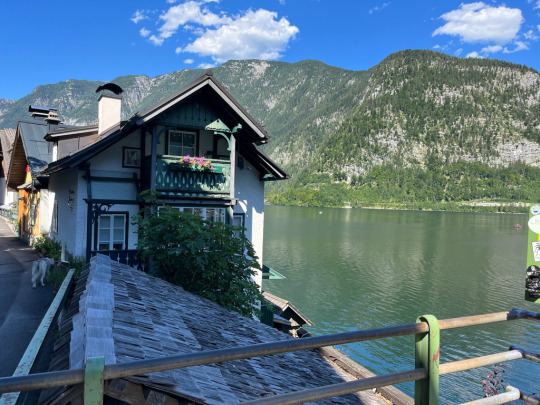
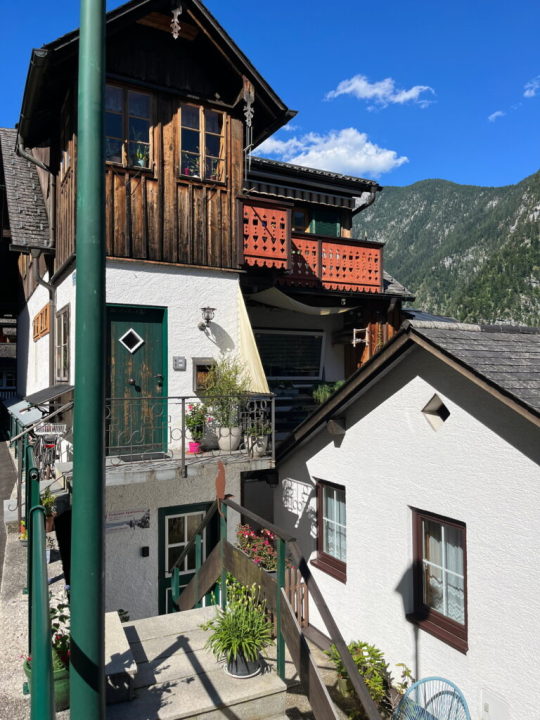
Als erstes besuche ich den kleinen Friedhof mit seinen geschnitzten Holzkreuzen, der Michaelskapelle aus dem 12. Jahrh., dem romantischen Durchgang und dem schönen Blick über den Ort. Hier gäbe es auch ein Beinhaus, d.h. eine Knochenkapelle, zu besichtigen.






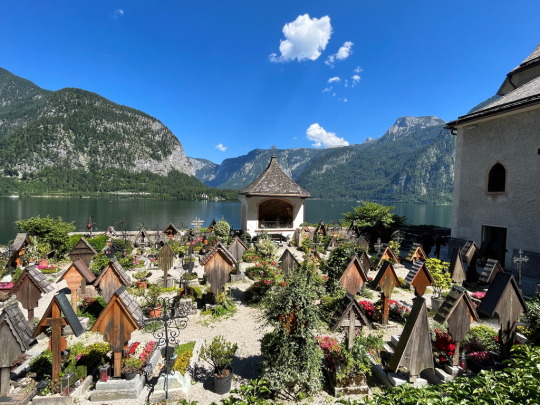
Ein Schild weist auf eine steile Treppe und ich quäle mich trotz der Hitze hinauf und hoffe auf einen alten Stollen-Eingang, den ich jedoch nicht entdecken kann. Dafür Erläuterungen zum Alpinismus. Die Besucher-Stollen liegen weiter oberhalb des Ortes im Hochtal, zu erreichen mit der Standseilbahn. Hier gibt es das Erlebnisbergwerk "Salzwelten" mit einer Wildwasserbahn, einen Skywalk und einen Aussichtsturm (Link). Über die Art der Salzgewinnung aus Sole hatte ich bereits in Frankreich in der Königlichen Saline von Arc-et-Senans Vieles erfahren. Mir ist es heute zu heiß und vor allen Dingen zu voll und ich begnüge mich mit dem Blick über den Ort und steige dann langsam wieder hinab ins Zentrum.




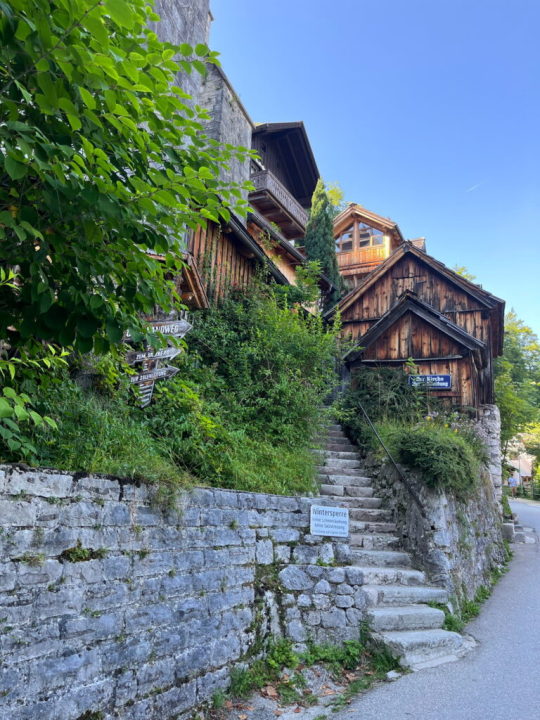

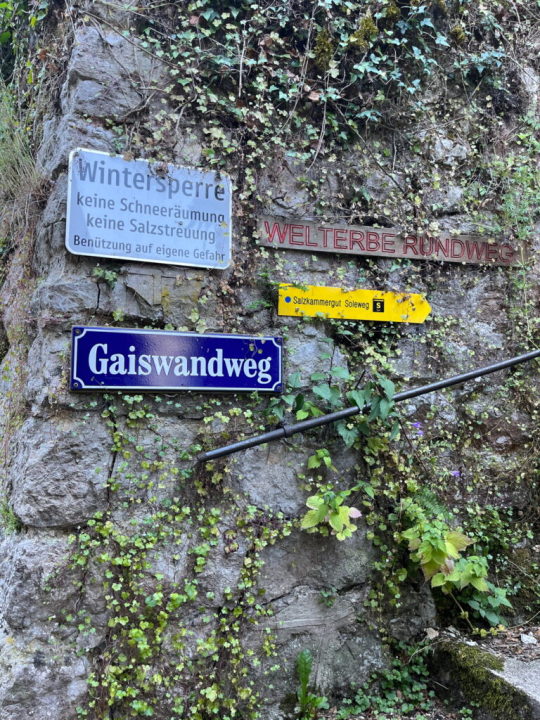
Das Zentrum des Ortes ist bunt, geschnitzt, blumengeschmückt und auf Besucher eingestellt. Die Gassen sind steil und schmal, die Häuser erstaunlich hoch, an einigen entdecke ich die Jahreszahlen. Neben dem Salzsiedehaus fließt das Wasser des Wasserfalls oben am Berg entlang. An einer Wunderquelle herrscht großer Andrang.


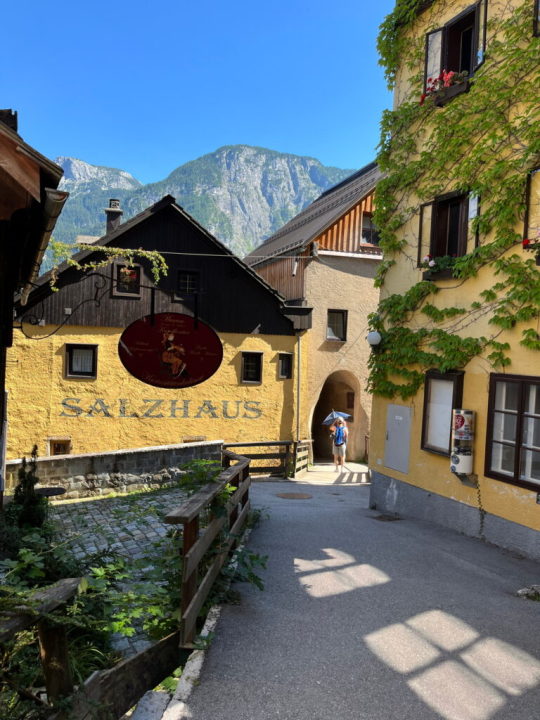
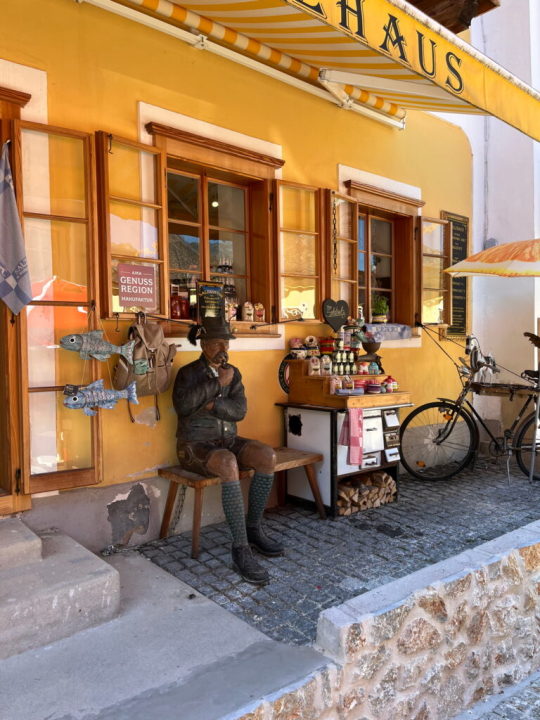

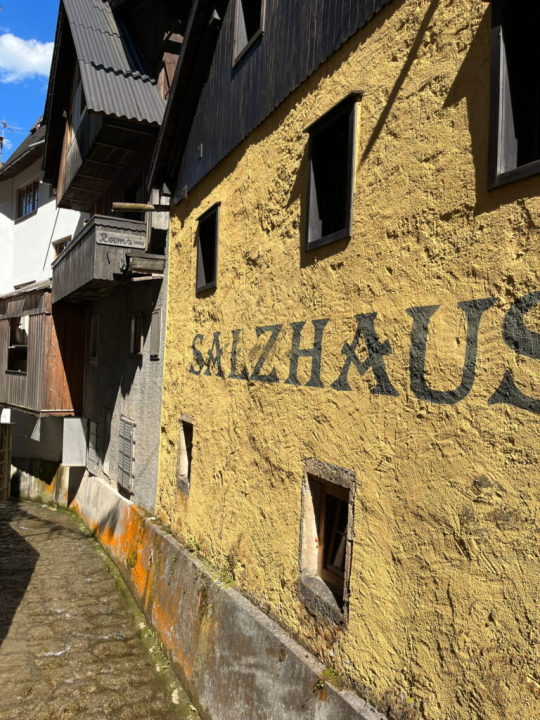




Um den Markt mit seiner schönen Dreifaltigkeitssäule reihen sich Restaurants und Eisdielen. Ich werfe einen Blick in die Kirche.
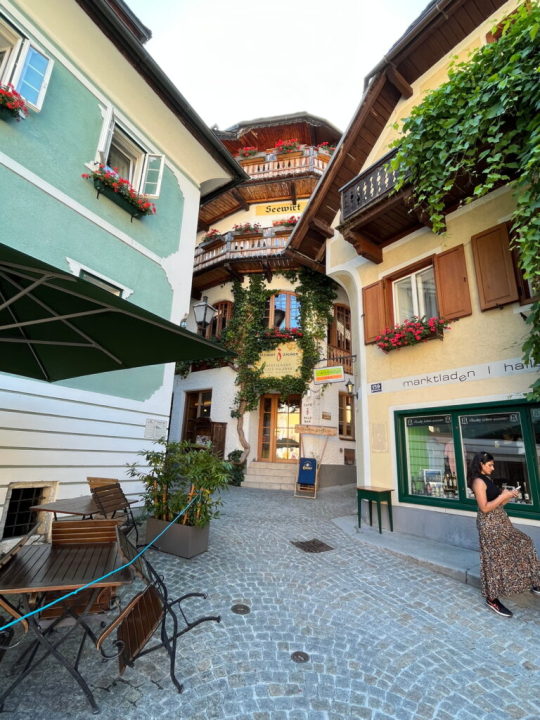

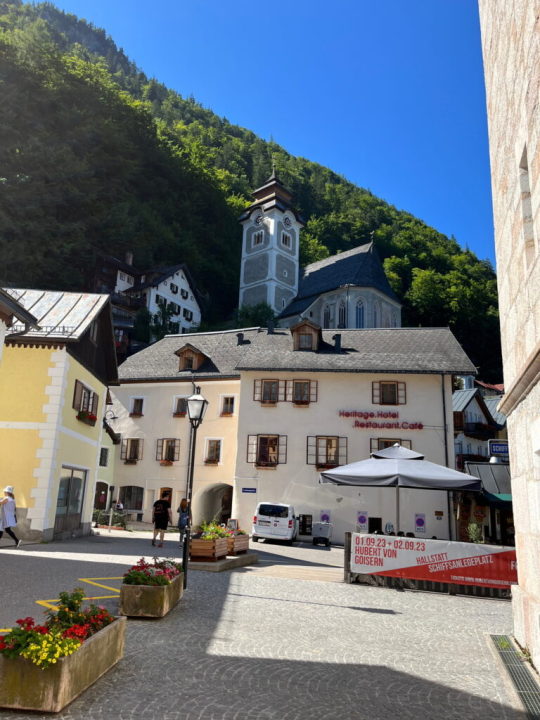


Vom Hafen aus wird besonders deutlich, wie steil die Hänge sind, an denen die Häuser in Etagen und auch die Kirche weit oben kleben.


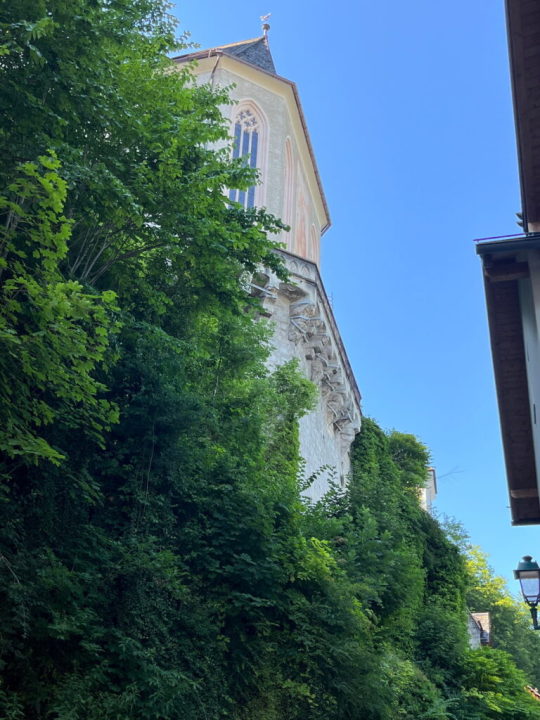
Ich habe einen einmaligen Ort gesehen, ein letzter Blick zurück, dann steige ich den Berg wieder hinauf zur Zufahrtsstraße, wo mein Auto parkt.

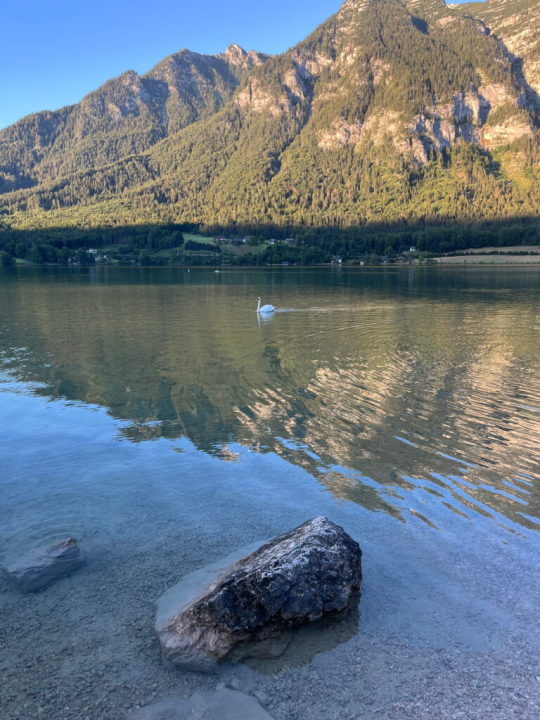
Den Abend und die Nacht verbringe ich einige Kilometer entfernt nach einem erfrischenden Bad in dem erstaunlicherweise sehr flachen Hallstätter See.
Resümee
Hallstatt ist ein sehenswerter Ort mit einzigartiger Architektur, malerisch gelegen und von seiner Geschichte her sehr interessant. Eingebettet in eine traumhafte Umgebung und mit vielen Annehmlichkeiten und Aktivitäten für seine Besucher kann man hier einige erlebnis- und abwechslungsreiche Urlaubstage verbringen und Ausflüge unternehmen. Hallstatt und die Dachsteinregion sind deshalb, am besten außerhalb der Hochsaison, meine absolute Empfehlung.
Die gesamte Tour go-south 2.0 ist hier beschrieben. Hier gehts zu meinem Welterbe-Projekt. Der Umbau meines Dacia Dokker als Minicamper ist hier detailliert nachzulesen. Dobbys nach und nach angepasste Einrichtung und Ausstattung hat sich auch in diesem megaheißen Sommer bewährt. Meine Übernachtungsplätze habe ich wieder auf park4night gesucht und unter 5Reisende bewertet.
Read the full article
#Abenteuermobil#Abenteuerreise#alleinunterwegs#Alleinreisen#Ausbau#Ausrüstung#Autoreise#Besichtigung#Camping#Camping-Mobil#Dachstein#Dacia-Dokker#DIY#Dobby#Erfahrungsbericht#Erkundung#Europa#Hallstatt#Hochdach-Kombi#Inspiration#Leichtbau#Minicamper#Österreich#Parkplatz#Reisebericht#Reisefotografie#Reisetagebuch#Reiseziele#Roadtrip#Rundfahrt
0 notes
Text
El Osario de Sedlec (también conocido como Kostnice Ossuary Beinhaus)...

El osario de Sedlec tiene una larga historia, que comenzó en el siglo XIII cuando el abad del monasterio de Sedlec (abad Henry) trajo un pu��ado de tierra de un viaje a la Tumba del Señor en Jerusalén. Esparció esta “tierra sagrada” por el cementerio de Sedlec, asegurando su lugar como uno de los lugares de entierro más deseados para la gente de toda Bohemia y los países vecinos. Todos querían ser enterrados en ese puñado de Tierra Santa y más de 30.000 lo fueron. Pero no pasó mucho tiempo antes de que simplemente no hubiera suficiente espacio para que todos descansaran en paz, y los cuerpos fueron trasladados a una cripta para dejar espacio a los recién muertos.
En 1870, se contrató a un tallador de madera local, František Rint, para la oscura tarea de arreglar artísticamente los miles de huesos. A Rint se le ocurrió el impresionante candelabro de Bone Church, así como el asombroso escudo de armas de Schwarzenberg, que incluye un cuervo picoteando la cabeza cortada de un turco, todo hecho de hueso humano. Rint se encargó de blanquear todos los huesos del osario para darle un aspecto uniforme a la habitación. La firma de su artista todavía está en la pared hoy en día, naturalmente, en su medio de elección, el hueso.
#Osario de Sedlec (también conocido como Kostnice Ossuary Beinhaus) en la República Checa le dan la bienvenida literalmente con los brazos ab#¿Esta es la imagen y algunos datos (O no) la “Historia” la pones tú? ¡La tuya! ¿Lo harás...?
1 note
·
View note
Text
I guess IG doesn’t let you save any reels with audio anymore so I’m sorry for the silence, but here’s clips from our small trip to Hallstatt yesterday. (I should probably invest in some real video editing software eventually…)
Sadly the Beinhaus was closed (which was actually the whole reason I wanted to go, but that’s on me for not checking first) so I’ll have to make another trip very soon before tourist season starts again. Luckily Hallstatt is only 45 minutes away from where I live 🏔️
91 notes
·
View notes
Text
Kobarid – Slowenien Slovenia West – Ein Naturjuwel
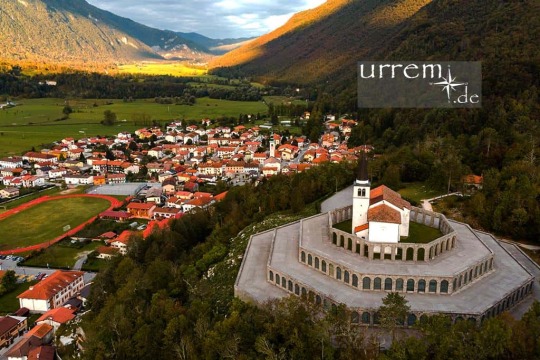
Kobarid (im deutschen Karfreit, im italienischen Caporetto) liegt in Slowenien und gilt als Naturjuwel. Die Region Kobarid liegt im Westen Sloweniens und gehört zum oberen Teil des Soca-Tals. Aktivurlauber und Outdoorfans lieben Kobarid als Urlaubsziel, weil man hier klettern sowie wandern kann, aber auch Kajaken oder Rafting sind sehr bliebt. Neben den sportlichen Aktivitäten gibt es aber auch wunderschöne Sehenswürdigkeiten und tolle Möglichkeiten für Ausflüge. Sehr nett und auf einen Kaffee lädt auch der Marktplatz ein, von hier aus kann diverse Sehenswürdigkeiten ansteuern.
Mit lediglich knapp 5.000 Einwohnern zählt Kobarid zu den eher kleineren Städten und es ist umgeben von den Julischen Alpen, welche Wanderern ein Begriff sind. Kobarid liegt direkt Fluss Soca und die Nachbarorte sind mit Bovec ca. 19km und Tolmin 15km entfernt. Die italienische Grenze ist zum greifen Nahe, mit nur noch ca. 5km.
Die Sehenswürdigkeiten von Kobarid
Die Napoleonbrücke über die Soca
Zu einer Top Foto Location gehört zweifelsohne die Napoleonbrücke direkt in Kobarid. Sie ist vielen Menschen bekannt und liegt nur etwa 900 Meter vom Stadtzentrum entfernt. Idealerweise parkt man 250m weit entfernt auf dem Parkplatz des Supermarktes - an und neben der Brücke gibt es keine Haltemöglichkeit!
Die Napoleon-Brücke hat einen historischen Hintergrund und bietet einen tollen Blick auf den smaragdgrünen Fluss Soca nebst Berge ringsum, auf man manchmal bunte Kajaks fahren sieht. Runter an den Fluss kommen Sie hier an der Stelle aber nicht.
Napoleonbrücke über den Fluss Nadiza
Ein weiterer Ausflugs-Tipp für einen schönen Tag: Geheimtipp! Eine Napoleonbrücke ;-) Ja, noch eine weitere Napoleon-Brücke. Aber diese “geheime” (eher eine weniger bekannte) Zweite liegt weit westlich von Kobarid.
Hier müssen Sie aus dem Zentrum mit ca. 20min Fahrzeit für die 13km rechnen. Diese Sehenswürdigkeit liegt nur 600m Luftlinie von der ital. Grenze entfernt.
Auf, an und unter der Brücke, die über den wundervollen Fluss Nadiza geht, finden Sie fast nur Einheimische. Badehose und Fotoapparat unbedingt mitnehmen. (Google Maps).
Weitere Highlights in und um Kobarid
Dann wäre da noch das nur 6km entfernte Bergdorf Dreznica. Recht romantisch mit einem schönen Ambiente und Kirche. Dort sind in der Umgebung einige kleine Wasserfälle und viel Natur die Belohnung. Von hier aus könnten Sie z.B. auch gut auf den Berg Krn wandern gehen.
Unweit dem Supermarkt-Parkplatz liegt das feine Käserei-Museum und das restaurierte Museum von Kobarid erzählt Besuchern gerne, was während des Ersten Weltkriegs passiert ist und ist durchaus interessant anzusehen.
Ein paar Meter aus der Stadt entfernt, quasi oberhalb der Napoleonbrücke, gibt es noch das italienische Beinhaus mit der St. Anton Kirche (siehe Titelfoto).
Es gibt auch in Kobarid einen Historischen Lehrpfad. Hierbei kommen Sie bspw. an vielen der o. g. Sehenswürdigkeiten vorbei = Dieser Pfad ist sehr empfehlenswert!
Slap Koziak - Kobarid Wasserfall
Sicherlich mit ein sehr guter Tipp ist auch der Kozjak Wasserfall. Er ist einer von 6 Fällen, der gut zu Fuß erreichbar ist. Dieser Wasserfall ist schon ein Hammer, denn er stürzt sich in eine Halbhöhle - von wo man ihn besichtigen kann. Gutes Schuhwerk sollten Sie dabei haben, es ist glitschig auf dem Weg.
Der Eintritt betrug 2022 nur 4,00 EUR. Der Weg ist gut beschildert - aber nichts mit Kinderwagen. Dort gibt es einen kostenlosen Parkplatz, der ca. 3 km vom Zentrum gelegen ist. Sie kommen an der Napoleonbrücke vorbei und müssen die enge Straße an der Soca entlang fahren.
Aktivurlaub liegt hier im Trend
In und um Kobarid kann man sich herrlich auspowern, denn die Region ist bekannt für seine Outdooraktivitäten. Wer gerne im Wasser unterwegs ist, wird sich an Rafting, Kajaken oder Canyoning erfreuen. Radfahrer erkunden auf zwei Rädern die Gegend und beim Wandern oder Klettern kann man seine Kräfte unter Beweis stellen. Es gibt hier sein sehr schönes und großes Wegnetz, das für Wanderer und Radfahrer perfekt ist.
Die Klettermöglichkeiten und Routen für Bergsteiger sind in unterschiedlichen Schwierigkeitsgraden. So können sich Anfänger, aber auch Profis nach Belieben verausgaben. Wer sich nicht auf eigene Faust in das Abenteuer stürzen möchte, kann sich ein Programm bei den ansässigen Ausflugsagenturen zusammenstellen lassen. Hier werden die Aktivitäten dann auch von Scouts begleitet.
Wann ist die beste Reisezeit für Kobarid?
Als gute Zeit Kobarid zu besuchen, gelten die Monate Mais bis September. Zu dieser Zeit ist es hier meist trocken und herrlich warm.
Im Frühling und Herbst dagegen muss man mit vielen Regentagen rechnen, obgleich die Temperaturen hier natürlich zum Wandern schon sehr angenehm sind. Winter bzw. Wintersport gibt es in diesem Ort nicht.
Hier im Ort sieht aber man oft und gerne Oleander in Kübeln, aber auch viel die Geranien an den Balkonen, welche zum schönen Anblick des Dorfes beitragen.
Übernachtungsmöglichkeiten
Kobarid mag zwar klein erscheinen, bietet aber durchaus Hostels, Pensionen oder Ferienwohnungen. Es lohnt sich in der Hauptsaison frühzeitig ein Zimmer zu buchen. In der Nebensaison findet man in der Regel aber auch ganz spontan eine Übernachtungsmöglichkeit bei einem der vielen Anbieter. Es gibt in Kobarid auch die Möglichkeit, auf einem Campingplatz zu übernachten. Dies ist perfekt, wenn man mit Wohnwagen oder Wohnmobil anreisen möchte.
Für das leibliche Wohl wird in Kobarid in zahlreichen Restaurants, Cafes und Gostilnas gesorgt, welche die traditionelle Küche anbieten, aber auch internationale Gerichte.
Slowenien Slovenija - das fünfgrünste Land der Welt - Foto- / Bildnachweis: Foto(s) Eigene und gekaufte Lizenz
Lesen Sie den ganzen Artikel
1 note
·
View note
